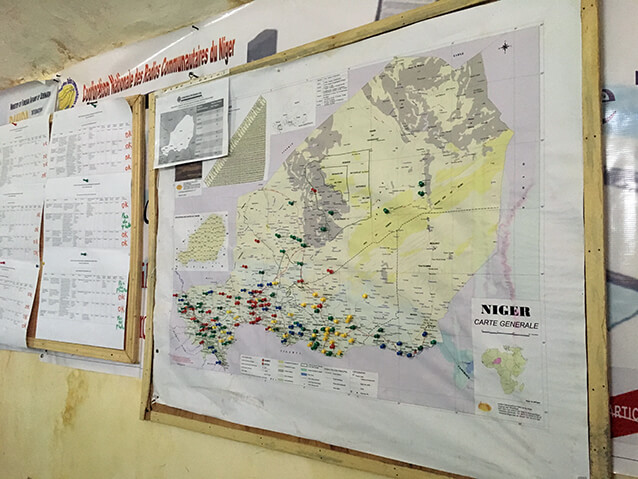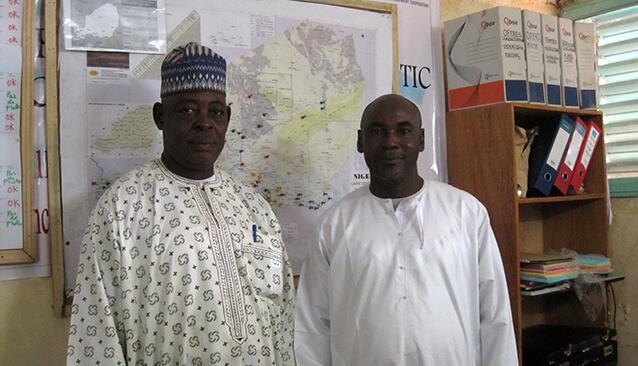
Moussa Hassane, secretary general and coordinator of CN-RACOM, in the office in Niamey. Photo: Gerd Kieffer-Døssing
“Without community radio, 70 per cent would have no access to information”
“It is because of community radios that the citizens [in Niger] know that it is a duty and a right to vote in elections. It is through community radio that the population have understood the importance of sending their children to school and going to the health centres in case of illness.”
Niamey, Niger: The first thing you see when entering the office is a map of Niger covered with pins in all colours.
Each pin represents the conditions of the community radio in the respective location; if it lacks equipment, is weak on content production, or maybe both, Moussa Hassane explains as he inspects the map in his office closely.
He is the Secretary General and coordinator of CN-RACOM, the National Coordination of Community Radios in Niger, who today represents 184 community radios spread out across all eight regions in this vast West African country.

Most popular media
With only one in five Nigeriens being literate, radio is by far the most used media in Niger, among the poorest and least developed countries in the world. In the rural areas – where almost 85 per cent of a population of 21,5 million citizens reside – community radio broadcasts in local languages are the main means of disseminating information and news to the local populations.
Operating on FM frequencies, the community radios can, depending on their transmitters, be listened to as far as 65 kilometres away reaching hundreds of thousands of potential listeners.
“Without the community radios, Niger would be a huge country where around 70 per cent would have no access to information,” Moussa Hassane says.
An important tool for local development
Most of the community radios in Niger are created within and by the communities. Behind are associations made up by citizens who have come together to create a community radio to fill the information gap in their respective areas.
“The community radio belongs to the community. It is a tool for local development created to ensure that the radio satisfies the population’s need for information and for sensitising the community in the zone where it is created,” explains Moussa Hassan.
Community radios receive no subsidies from the state as they are not recognised as a media in the same way as, for instance, state radio and private radios are. Instead, they make ends meet on a more ad-hoc basis where staff donates their time on a voluntary basis. Only few radio-staff members are paid, depending on the small revenue the radios manage to generate.
Most of the revenue consists of donations from the community itself and from the money paid specifically to have certain information and programmes broadcast. It could be local authorities disseminating messages on when the national vaccination programmes visit the area, or development organisations like e.g. UNICEF wanting to inform on their work in the region, or locals who want to announce a marriage or a baptism, etc.
Conflict prevention via radio
To Moussa Hassane there is no doubt about the important role played by the community radios in his country.
“It is because of community radios that the citizens [in Niger] know that it is a duty and a right to vote in elections. It is through community radio that the population have understood the importance of sending their children to school and going to the health centres in case of illness.”
In terms of creating social cohesion and preventing violence, the community radios can also have a mediating effect.
“[In Niger] We might live in the same country or in the same town, but our cultures and the way we see things are very different. When we engage in dialogue, we understand the other person better and we can continue developing our country together. The community radios help to initiate that dialogue,” says Moussa Hassane.
Fully equipped office
CN-RACOM was established back in 2004, but until 2014, the year where CN-RACOM entered into a partnership with IMS, the association consisted merely of a dusty office with two stools and a desk, and it had no functional structure in place allowing them to live up to the expectations of their 34 radio members at that time.
Much has changed since then.
Through and with support from IMS and other partners, CN-RACOM has undergone an enormous development and capacity building, and Moussa Hassane is visibly proud of the achievements: They now have small functional office in all of Niger’s eight regions, they have a webpage, a Facebook page and the number of members of CN-RACOM has grown to 184.
Following a field trip in 2014, where the CN-RACOM team talked to both radio personnel as well as members from the communities, they put together the first strategic plan, which the members endorsed at the general meeting the same year. Only two out of 49 activities from the plan have not been fulfilled.

The magic number of 266
The partnership with IMS continues as part of the IMS Sahel Programme which is implemented from 2018-2021 (download the programme presentation document below) and Moussa Hassane has huge expectations for the years to come.
On the national level, CN-RACOM is working intensely to make the government include the community radios in the law on financial support to Nigerien media. If they succeed, the result would be a yearly economic subsidy of approximately 1,850 Euros for each radio – a huge sum in Niger, which would change the situation of the radios remarkably.
And Moussa Hassane is quite optimistic:
“The authorities listen to us. They know the role the community radios play in the country,” he says and adds with a cunning smile: “And also… the people who voted for them live in these areas.”
Other goals of CN-RACOM relate to an overall strengthening of the community radios in terms of both improving their content and their equipment, building radio-directors’ capacity in terms of management and budget planning and – of course – increasing the member base of the CN-RACOM:
“Our aim is that all communes in Niger will have a community radio by end 2019 – that is 266 community radios in total,“ Moussa Hassane says while glancing up on the map on the wall. There is definitely room for an additional 82 pins.




